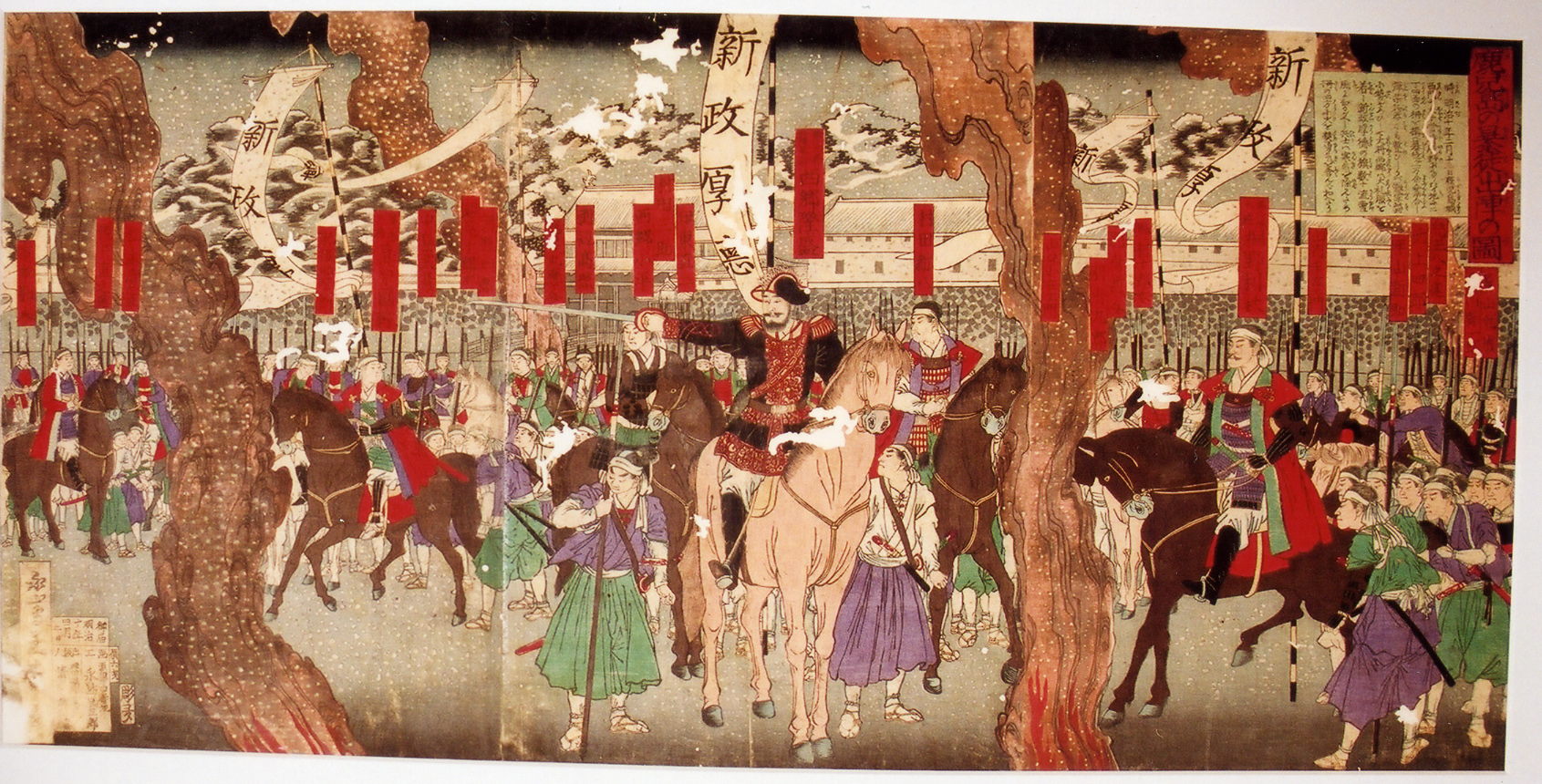The Meiji Restoration: Major Reforms
Key Terms
- Saigō Takamori 西郷隆盛 (1827-1877) Satsuma
- Ōkubo Toshimichi 大久保利通 (1803-1877) Satsuma
- Yamagata Aritomo 山縣有朋 (1838-1922) Chōshū
- Itō Hirobumi 伊藤博文 (1841-1909) Chōshū
- Iwakura Tomomi 岩倉具視 (1825-1883)
- Etō Shinpei 江藤新平 (1834-1874) Saga
- "Japan house" 倭館 (J. wakan/K. waegwan)
- Meiji Restoration (Meiji ishin 明治維新)
- revolution (isshin 一新)
- Return of Ancient Kingly Rule (ōsei fukko 王政復古)
Centralization of Political Authority
- Daimyo "voluntarily" surrender their investitures to emperor (1869)
- Made compulsory in 1871 - "birth of modern Japan"
- Daimyō are reappointed as prefectural governments, but gradually replaced by central government officials
- Daimyō received lifetime pensions equal to 10% of their domain's tax revenue
Reform/Eliminated of Samurai Estate
- Samurai are allowed to convert stipends into bond in 1873
- 1876
- Stipend conversion is compulsory
- Samurai lose right to wear swords in public
Tax reform
- Announced 1872, not fully implemented until 1880
- Key features
- Taxes are now national and go to a national treasury
- Land is now fully alienable
- Tax is NOT on yield, but 3% of value
- No relief for bad harvests
- Owner is taxpayer
Military Reform and Conscription
Education
- Basic education
- Plans announced in 1872, not fully implemented until late 1890s
- one primary school for every 600 people
- compulsory BUT local communities must pay for schools
- initial plan is for eight years of schooling
- shortened to 4 in 1879
- increased to 1907 goes to 6 yrs.
- Progress of schools
- By 1880 there are 28,000 primary schools with 2 million students
- Enrollment is 40% in 1880
- 46% in 1886
- 60% by 1895
- 90% by 1900
- Practical problems
- Shortage of skilled teachers
- Available staff is suspect
- Political radicals
- Buddhist monks
- in 1879 the Emperor condemns indiscriminate emulation of Western way
- in 1886 it extends control over curriculum
- Higher education
- Japan was to be divided into 8 educational districts
- each with one university and 32 secondary schools
- this works out to one secondary school for every 117,187 people
- MIDDLE SCHOOL IS AS ELITE AS A UNIVERSITY
Industrialization
- Government invests in railroads, telegraph, modern factories
- Major projects lose money, but are sold to well-connected entrepreneurs
- By the 1880s, government has sold its interest in textiles and light industry, but remains committed to essential industries, such as shipbuilding and steel
Reform of Customs
- Bans on traditional haircuts
- Change of calendar
- Introduction of state Shintō
Legal Reforms
- For civil code, move to translate Napoleonic Code
- For criminal code, work on Tang, Ming, and Qing codes
- Both are abandoned for case law
- No new civil code until 1898
Foreign policy and the Iwakura mission
- Common goal is revision of unequal treaties
- Iwakura mission 岩倉使節団 (December 1871 to September 1873)
- Goals are preparation for treaty renegotiation
- Study mission
- High ranking officials as well as researchers and translators
- Visit US, UK, France, Belgium, Netherlands, Prussia, Russia, Italy -- part of the mission visits Egypt, Ceylon, Singapore, Shanghai
- Mission requires government split
- Members of the mission
- Ōkubo Toshimichi
- Kido Kōin
- Itō Hirobumi
- Iwakura Tomomi
- Members of the "caretaker" government
- Saigō Takamori
- Yamagata Aritomo
- Etō Shinpei
- Sanjō Sanetomi
- Itagaki Taisuke
- Inoue Kaoru
- Experiences of the mission
- Disappointed - despite high hopes, the mission realizes that treaty renegotiation will take years
- Impressed by depth of industrialization
- Struck by diversity of models of power -- Berlin vs. Washington
- Internal dissent -- angry with each other, some members (Ōkubo) return early
- Experiences of "caretaker" government
- Continue program of radical reform laid out in 1871 including
- national conscription
- national taxation
- Extremely ambitious and fiscally irresponsible
- Education minister wants ¥2M
- Justice minister (Etō Shinpei) wants ¥1M for immediate revision of civil law and new court system
- Inoue (finance minister) says this will destroy Japan's ability to develop a stable currency
- Yamagata gets ¥8M for army but is tainted by scandals
- Domestic stand-off and Sanjō asks mission to hurry home (Jan 1873)
- Ōkubo arrives in May 1873
- Kido visits Russia, Italy, Austria, arrives July 1873
- Iwakura does not arrive until September 1873
- Foreign policy crisis
- How to deal with Korean court (Yi dynasty 李王家) when it refuses to recognizes Meiji government
- Problem of 倭館 (J. wakan/K. waegwan) in Busan
- Changes in clothing and manners
- Saigō insists that he will go to Korea as special envoy -- will either resolve the problem or be killed. The later will give Japan causus belli
- Council votes in favor of Saigō in August, but agree to revisit question once the rest of the Iwakura mission returns
- Ōkubo argues this is rash, forces change, Sept 1873
- Saigō and his allies resign in outrage
- Saigō Takamori
- Etō Shinpei
- Itagaki Taisuke
Domestic rebellions and dissent
- Violent rebellion
- Leaders are often members of "caretaker" government
- Saga Rebellion 佐賀の乱 (1874) led by Etō Shinpei
- Satsuma Rebellion 西南戦争 (1877) led by Saigō Takamori

- Non-violent dissent
- Samurai dissidents like Itagaki turn to popular assembly as means of pressuring government

